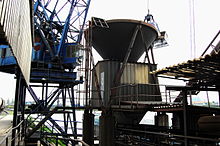Bulk material

Bulk material is a powdery, granular or lumpy mixture that is present in a pourable form. The properties of bulk goods are determined by the grain size (grain size) and the grain distribution as well as the bulk density , the roughness , the humidity and the temperature . A distinction is made between cohesionless (free-flowing) and cohesive (cohesive) bulk solids.
Schütten is a term defined from the DIN standards of transport and process engineering for the handling of bulk goods. A bulk , in particular loose bulk, denotes goods that can move freely in a container or are not otherwise secured in their position.
The bulk mechanics deals with storage - and transport conditions of bulk materials such as angle of repose (friction angle), discharge behavior of silos , fluid ization and bulk density. After exceeding an activation energy, bulk goods can behave like a fluid, i.e. flow. The particles are essentially retained or do not change their shape during transport. The most important parameter for this is the pourability . The properties of bulk solids are treated physically in the theory of granular matter .
Examples
Bulk materials include building materials such as topsoil , sand, gravel and cement, as well as raw materials such as ore , coal , clay or road salt . Also includes foods such as cereals , sugar , salt , coffee and flour to the group of bulk materials. Powdered goods such as pigments as well as fillers , granulates and pellets can also be assigned.
Storage and discharge
Due to their material properties, bulk goods are often stored in silos or bunkers. Weather-resistant goods can also be stored outdoors.
Free-flowing bulk goods can easily be discharged with a rotary valve, for example, or with the aid of a pusher. In the case of cohesive, hygroscopic, segregating, leaking, non-flowable or pasty bulk goods, the exact dosage in particular is more than demanding. Such difficult (complex) bulk goods can be discharged with a tilting beam floor .
transport
When it comes to transport, a distinction is made between continuous, i.e. uninterrupted, and discontinuous transport.
The continuous transport processes include simple equipment such as hoses and pipes (so-called pneumatic conveying ), but also complex systems such as continuous belt conveyors (troughed belt conveyors, conveyor belts), continuous chain conveyors , vibratory conveyors and bucket elevators as well as rotary valves for discharge and metering. The double pendulum flap is also used to transport coarse bulk goods.
In the case of bulk material silos or bunkers ( e.g. on ships , also referred to as falling material there), discontinuous transport takes place in dump trucks and high-sided vehicles (road and rail) as well as in silo wagons , silo vehicles , semi-trailers with sliding floors and as bagged goods or in big bags .
In the context of transport, bulk cargo is one of the transport goods. Other types of transport goods are, for example, general cargo and suction goods .
Bulk solids technology
In bulk material technology, one deals with the functional design of mechanical process engineering apparatus, in particular silos . Knowledge of experimentally determined bulk material properties enables a silo design with the aim of avoiding outflow disturbances, such as manhole formation, bridging or segregation .
Properties determined experimentally are:
- the bulk strength,
- the bulk density,
- the effective angle of friction ,
- the wall friction angle
See also
literature
- Dietmar Schulze: Powder and bulk goods, flow properties and handling. Third edition, Springer Verlag, Berlin 2014, ISBN 978-3-540-34082-9
- DIN EN 1991-4: Actions on structures - Part 4: Actions on bulk material silos German version EN 1991-4: 2006, 119 S., Beuth Verlag GmbH



